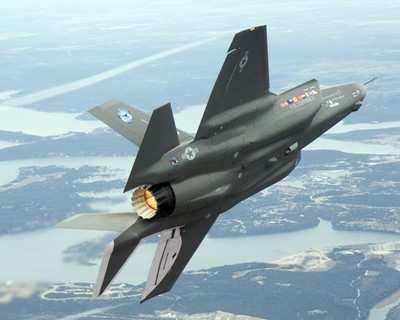Fri, Oct 19, 2007
BAE Systems Begins Work On Demonstrator Plane's Tail
Section
BAE Systems tells ANN it has started manufacture of the F-35
Lightning II Carrier Variant (CV). The CV aircraft is the final
F-35 variant to start production.

The initial manufacturing on the CV variant is of the first
titanium and aluminium frames that will form part of the aft
fuselage for the first CV aircraft, which is planned to take to the
skies in 2009. The aft fuselage and empennage for each F-35
Lightning II variant are being designed, engineered and built by
BAE Systems.
In addition to the CV, BAE is also working concurrently on the
conventional takeoff and landing (CTOL) version, as well as the
short takeoff and vertical landing (STOVL) F-35 variants.
"Developing three variants of the same aircraft, at the same
time, is a first for the military aircraft industry," said BAE
Systems' F-35 Lightning II Managing Director Tom Fillingham. "We
are breaking new ground on the F-35 program. Each variant has its
own unique challenges that have required some innovative solutions
from the team. Now that we have all three variants in manufacture
it is great to see all the design and engineering work coming
together."
The F-35 Lightning II program is the world's largest defense
program, and is currently in the System Development and
Demonstration (SDD) phase. The SDD phase will see the production of
21 test aircraft. Fifteen F-35s will undergo flight test, and six
will be used for static testing. Another high-fidelity full-scale
model F-35 will validate the aircraft's radar signature.
The aft fuselages for all variants of the F-35 are produced at
BAE Systems' Samlesbury facility in Lancashire, UK. As production
rates increase in the SDD phase, the BAE Systems team is starting a
new aircraft assembly every four weeks.
The three variants of the F-35 Lightning II are being developed
to meet the different performance requirements of the US and UK
armed forces. The Carrier Variant (CV) is being designed for the US
Navy, to cope with the demands of the catapult launches and
arrested landings on large US aircraft carriers. The Conventional
Take Off and Landing (CTOL) variant will meet the needs of the US
Air Force, while the Short Take Off and Vertical Landing (STOVL)
variant is being developed to meet the operational requirements of
the US Marine Corp and the UK.
More News
19-Year-Old Pilot Was Attempting to Fly Solo to All Seven Continents On his journey to become the first pilot to land solo on all seven continents, 19-year-old Ethan Guo has hit a >[...]
From 2017 (YouTube Edition): A Quality LSA For Well Under $100k… Aeroprakt unveiled its new LSA at the Deland Sport Aviation Showcase in November. Dennis Long, U.S. Importer>[...]
Hazardous Weather Information Summary of significant meteorological information (SIGMET/WS), convective significant meteorological information (convective SIGMET/WST), urgent pilot>[...]
Aero Linx: Historic Aircraft Association (HAA) The Historic Aircraft Association (HAA) was founded in 1979 with the aim of furthering the safe flying of historic aircraft in the UK>[...]
"We would like to remember Liam not just for the way he left this world, but for how he lived in it... Liam was fearless, not necessarily because he wasn't afraid but because he re>[...]
 TikToker Arrested After Landing His C182 in Antarctica
TikToker Arrested After Landing His C182 in Antarctica Classic Aero-TV: Versatile AND Practical - The All-Seeing Aeroprakt A-22 LSA
Classic Aero-TV: Versatile AND Practical - The All-Seeing Aeroprakt A-22 LSA ANN's Daily Aero-Term (06.27.25): Hazardous Weather Information
ANN's Daily Aero-Term (06.27.25): Hazardous Weather Information ANN's Daily Aero-Linx (06.27.25)
ANN's Daily Aero-Linx (06.27.25) Aero-News: Quote of the Day (06.27.25)
Aero-News: Quote of the Day (06.27.25)



